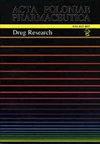红松和西伯利亚松:化学成分和药理特征综述
IF 0.4
4区 医学
Q4 PHARMACOLOGY & PHARMACY
引用次数: 0
摘要
背景:西伯利亚松(Pinus sibirica)和红松(Pinus koraiensis)同属松科松分节。从它们中分离出的最丰富的一类生物活性化合物是萜烯、酚类和脂肪酸。上述植物的不同形式已在民间医学中用于预防和治疗许多疾病。西伯利亚松被用来治疗风湿病、关节炎以及治疗感染、真菌疾病和伤口。它还被认为具有降血脂、抗过敏和防腐的特性。同样,红松传统上用于治疗咳嗽、感染、伤口和风湿病。此外,红松精油具有抗肿瘤、抗衰老和镇静作用。目的:收集西伯利亚松和红松植物不同制剂的化学成分和药理作用的文献资料,涵盖从临床前数据到即将进行的临床研究。方法:通过检索Medline/PubMed、SCOPUS、Embase、Web of Science等数据库收集文献。没有出版年份的限制,搜索不仅限于英文文章。结果:根据文献报道,西伯利亚松和红松富含萜烯和酚类物质,主要用于抗肿瘤、保肝或抑制食欲的研究。结论:本文综述了西伯利亚松和红松的化学成分、生物学特性和治疗用途等方面的资料。在这些植物中发现的许多成分具有巨大的潜力,可以用于研究许多药理作用,从而生产出创新的治疗剂。本文章由计算机程序翻译,如有差异,请以英文原文为准。
Korean and Siberian pine: Review of chemical composition and pharmacological profile
Background: Pinus sibirica and Pinus koraiensis are belonging to the same subsection Strobus, within the Pinaceae family. The most abundant classes of bioactive compounds isolated from them are terpenes, phenols and fatty acids. Different forms of the abovementioned plants have been used in folk medicine for the prevention and treatment of many diseases. Pinus sibirica has been used to cure rheumatism, arthritis as well as to treat infections, fungal diseases and wounds. It is also considered to exhibit a hypolipidemic, anti-allergic and antiseptic properties. Similarly, Pinus koraiensis is used tradidionaly to treat cough, infections, wounds and rheumatism. Furthermore, essential oil from Korean pine has antitumor, anti-ageing, and sedative effects. Objective: Our aim was to compile literature data regarding chemical composition and pharmacological effects of different preparations from Pinus sibirica and Pinus koraiensis plants, covering from pre-clinical data to upcoming clinical studies. Method: Articles were collected by searching databases: Medline/PubMed, SCOPUS, Embase, and Web of Science. There was no limitation for year of publication and search was not limited only on articles in English language. Results: Given the literature reports, both Siberian and Korean pines, rich in terpenes and phenols, are mainly used in investigations where they expressed antitumor, hepatoprotective or appetite suppressant properties. Conclusion: This review provided compilation of available data about chemical composition, biological profile and therapeutic usage of Pinus sibirica and Pinus koraiensis. Numerous ingredients found in those plants have great potential for examination of numerous pharmacological effects which can lead to production of innovative therapeutic agent.
求助全文
通过发布文献求助,成功后即可免费获取论文全文。
去求助
来源期刊
CiteScore
0.80
自引率
0.00%
发文量
74
审稿时长
6-12 weeks
期刊介绍:
The international journal of the Polish Pharmaceutical Society is published in 6 issues a year. The journal offers Open Access publication of original research papers, short communications and reviews written in English, in all areas of pharmaceutical sciences. The following areas of pharmaceutical sciences are covered: Analysis, Biopharmacy, Drug Biochemistry, Drug Synthesis, Natural Drugs, Pharmaceutical Technology, Pharmacology and General.
A bimonthly appearing in English since 1994, which continues “Acta Poloniae Pharmaceutica”, whose first issue appeared in December 1937. The war halted the activity of the journal’s creators. Issuance of “Acta Poloniae Pharmaceutica” was resumed in 1947. From 1947 the journal appeared irregularly, initially as a quarterly, then a bimonthly. In the years 1963 – 1973 alongside the Polish version appeared the English edition of the journal. Starting from 1974 only works in English are published in the journal. Since 1995 the journal has been appearing very regularly in two-month intervals (six books a year). The journal publishes original works from all fields of pharmacy, summaries of postdoctoral dissertations and laboratory notes.

 求助内容:
求助内容: 应助结果提醒方式:
应助结果提醒方式:


